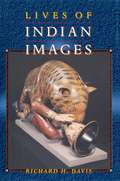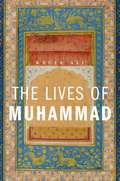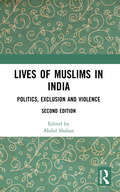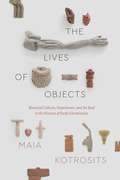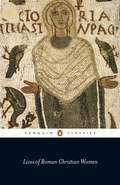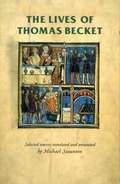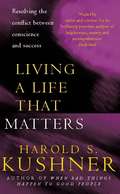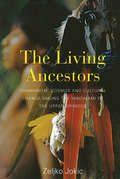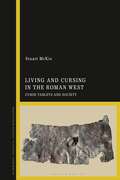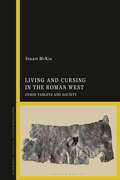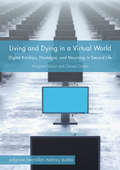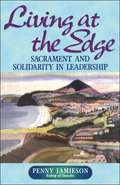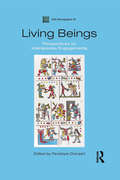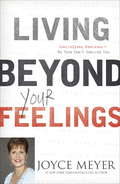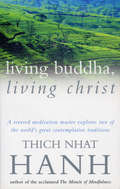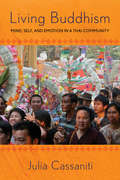- Table View
- List View
The Lives of David Brainerd: The Making of an American Evangelical Icon (Religion in American Life)
by John A GriggThe story of the eighteenth century preacher David Brainerd has been told in dozens of popular biographies, articles, and short essays. Almost without exception, these works are celebratory, even hagiographic in nature, making him into a kind of Protestant saint, a model for generations of missionaries. This book will be the first scholarly biography of Brainerd, drawing on everything from town records and published sermons to hand-written fragments to tell the story not only of Brainerd's life, but of his legend.
Lives of Indian Images
by Richard H. DavisFor many centuries, Hindus have taken it for granted that the religious images they place in temples and home shrines for purposes of worship are alive. Hindu priests bring them to life through a complex ritual "establishment" that invokes the god or goddess into material support. Priests and devotees then maintain the enlivened image as a divine person through ongoing liturgical activity: they must awaken it in the morning, bathe it, dress it, feed it, entertain it, praise it, and eventually put it to bed at night. In this linked series of case studies of Hindu religious objects, Richard Davis argues that in some sense these believers are correct: through ongoing interactions with humans, religious objects are brought to life.Davis draws largely on reader-response literary theory and anthropological approaches to the study of objects in society in order to trace the biographies of Indian religious images over many centuries. He shows that Hindu priests and worshipers are not the only ones to enliven images. Bringing with them differing religious assumptions, political agendas, and economic motivations, others may animate the very same objects as icons of sovereignty, as polytheistic "idols," as "devils," as potentially lucrative commodities, as objects of sculptural art, or as symbols for a whole range of new meanings never foreseen by the images' makers or original worshipers.
The Lives of Muhammad
by Kecia AliKecia Ali delves into the many ways the Prophet’s life story has been told from the earliest days of Islam to the present, by both Muslims and non-Muslims. Emphasizing the major transformations since the nineteenth century, she shows that far from being mutually opposed, these various perspectives have become increasingly interdependent.
The Lives of Muhammad
by Kecia AliKecia Ali delves into the many ways the Prophet’s life story has been told from the earliest days of Islam to the present, by both Muslims and non-Muslims. Emphasizing the major transformations since the nineteenth century, she shows that far from being mutually opposed, these various perspectives have become increasingly interdependent.
Lives of Muslims in India: Politics, Exclusion and Violence
by Abdul ShabanThe fast-consolidating identities along religious and ethnic lines in recent years have considerably ‘minoritised’ Muslims in India. The wide-ranging essays in this volume focus on the intensified exclusionary practices against Indian Muslims, highlighting how, amidst a politics of violence, confusing policy frameworks on caste and class lines, and institutionalised riot systems, the community has also suffered from the lack of leadership from within. At the same time, Indian Muslims have emerged as a ‘mass’ around which the politics of ‘vote bank’, ‘appeasement’, ‘foreigners’, ‘Pakistanis within the country’, and so on are innovated and played upon, making them further apprehensive about asserting their legitimate right to development. The important issues of the double marginalisation of Muslim women and attempts to reform the Muslim Personal Law by some civil society groups is also discussed. Contributed by academics, activists and journalists, the articles discuss issues of integration, exclusion and violence, and attempt to understand categories such as ‘identity’, ‘minority’, ‘multiculturalism’ and ‘nationalism’ with regard to and in the context of Indian Muslims. This second edition, with a new introduction, will be of great interest to scholars and researchers in sociology, politics, history, cultural studies, minority studies, Islamic studies, policy studies and development studies, as well as policymakers, civil society activists and those in media and journalism.
Lives of Muslims in India: Politics, Exclusion and Violence
by Abdul ShabanThe fast-consolidating identities along religious and ethnic lines in recent years have considerably ‘minoritised’ Muslims in India. The wide-ranging essays in this volume focus on the intensified exclusionary practices against Indian Muslims, highlighting how, amidst a politics of violence, confusing policy frameworks on caste and class lines, and institutionalised riot systems, the community has also suffered from the lack of leadership from within. At the same time, Indian Muslims have emerged as a ‘mass’ around which the politics of ‘vote bank’, ‘appeasement’, ‘foreigners’, ‘Pakistanis within the country’, and so on are innovated and played upon, making them further apprehensive about asserting their legitimate right to development. The important issues of the double marginalisation of Muslim women and attempts to reform the Muslim Personal Law by some civil society groups is also discussed. Contributed by academics, activists and journalists, the articles discuss issues of integration, exclusion and violence, and attempt to understand categories such as ‘identity’, ‘minority’, ‘multiculturalism’ and ‘nationalism’ with regard to and in the context of Indian Muslims. This second edition, with a new introduction, will be of great interest to scholars and researchers in sociology, politics, history, cultural studies, minority studies, Islamic studies, policy studies and development studies, as well as policymakers, civil society activists and those in media and journalism.
The Lives of Objects: Material Culture, Experience, and the Real in the History of Early Christianity (Class 200: New Studies in Religion)
by Maia KotrositsOur lives are filled with objects—ones that we carry with us, that define our homes, that serve practical purposes, and that hold sentimental value. When they are broken, lost, left behind, or removed from their context, they can feel alien, take on a different use, or become trash. The lives of objects change when our relationships to them change. Maia Kotrosits offers a fresh perspective on objects, looking beyond physical material to consider how collective imagination shapes the formation of objects and the experience of reality. Bringing a psychoanalytic approach to the analysis of material culture, she examines objects of attachment—relationships, ideas, and beliefs that live on in the psyche—and illustrates how people across time have anchored value systems to the materiality of life. Engaging with classical studies, history, anthropology, and literary, gender, and queer studies, Kotrosits shows how these disciplines address historical knowledge and how an expanded definition of materiality can help us make connections between antiquity and the contemporary world.
The Lives of Objects: Material Culture, Experience, and the Real in the History of Early Christianity (Class 200: New Studies in Religion)
by Maia KotrositsOur lives are filled with objects—ones that we carry with us, that define our homes, that serve practical purposes, and that hold sentimental value. When they are broken, lost, left behind, or removed from their context, they can feel alien, take on a different use, or become trash. The lives of objects change when our relationships to them change. Maia Kotrosits offers a fresh perspective on objects, looking beyond physical material to consider how collective imagination shapes the formation of objects and the experience of reality. Bringing a psychoanalytic approach to the analysis of material culture, she examines objects of attachment—relationships, ideas, and beliefs that live on in the psyche—and illustrates how people across time have anchored value systems to the materiality of life. Engaging with classical studies, history, anthropology, and literary, gender, and queer studies, Kotrosits shows how these disciplines address historical knowledge and how an expanded definition of materiality can help us make connections between antiquity and the contemporary world.
The Lives of Objects: Material Culture, Experience, and the Real in the History of Early Christianity (Class 200: New Studies in Religion)
by Maia KotrositsOur lives are filled with objects—ones that we carry with us, that define our homes, that serve practical purposes, and that hold sentimental value. When they are broken, lost, left behind, or removed from their context, they can feel alien, take on a different use, or become trash. The lives of objects change when our relationships to them change. Maia Kotrosits offers a fresh perspective on objects, looking beyond physical material to consider how collective imagination shapes the formation of objects and the experience of reality. Bringing a psychoanalytic approach to the analysis of material culture, she examines objects of attachment—relationships, ideas, and beliefs that live on in the psyche—and illustrates how people across time have anchored value systems to the materiality of life. Engaging with classical studies, history, anthropology, and literary, gender, and queer studies, Kotrosits shows how these disciplines address historical knowledge and how an expanded definition of materiality can help us make connections between antiquity and the contemporary world.
The Lives of Objects: Material Culture, Experience, and the Real in the History of Early Christianity (Class 200: New Studies in Religion)
by Maia KotrositsOur lives are filled with objects—ones that we carry with us, that define our homes, that serve practical purposes, and that hold sentimental value. When they are broken, lost, left behind, or removed from their context, they can feel alien, take on a different use, or become trash. The lives of objects change when our relationships to them change. Maia Kotrosits offers a fresh perspective on objects, looking beyond physical material to consider how collective imagination shapes the formation of objects and the experience of reality. Bringing a psychoanalytic approach to the analysis of material culture, she examines objects of attachment—relationships, ideas, and beliefs that live on in the psyche—and illustrates how people across time have anchored value systems to the materiality of life. Engaging with classical studies, history, anthropology, and literary, gender, and queer studies, Kotrosits shows how these disciplines address historical knowledge and how an expanded definition of materiality can help us make connections between antiquity and the contemporary world.
Lives of Roman Christian Women
by Carolinne White'Perpetua shouted out with joy as the sword pierced her, for she wanted to taste some of the pain and she even guided the hesitant hand of the trainee gladiator towards her own throat'Lives of Roman Christian Women is a unique collection of letters and documents from the third to the fifth centuries, celebrating Christian women from across the Roman Empire. During a crucial period in which Christianity transformed from a persecuted faith to the official religion of the Empire, these writings reveal the women who chose to dedicate their lives to Christ, by embracing martyrdom or by adopting a life of poverty and prayer, renouncing not only wealth but also their duties as wives and mothers.
The lives of Thomas Becket (Manchester Medieval Sources)
by Rosemary Horrox Simon MacleanThis collection tells the story of Thomas Becket's turbulent life, violent death and extraordinary posthumous acclaim in the words of his contemporaries. The only modern collection from the twelfth-century Lives of Thomas Becket in English and features all his major biographers, including many previously untranslated extracts. Providing both a valuable glimpse of the late twelfth-century world, and an insight into the minds of those who witnessed the events. By using contemporary sources, this book is the most accessible way to study this central episode in medieval history. Thomas Becket features prominently in most medieval core courses. This book allows the subject to be taught as never before, and is highly suitable as a set text.
Living a Life that Matters: Resolving the Conflict Between Conscience and Success
by Harold KushnerIn this inspiring, uplifting and timely book, Harold Kushner addresses our craving for significance, the need to know that our lives and choices mean something. We sometimes confuse power, wealth and fame with true achievement. We can do great things, and occasionally terrible things, to reassure ourselves that we matter to the world. We need to think of ourselves as good people and are troubled when we compromise our integrity to be successful and important.In Living a Life That Matters, Rabbi Kushner suggests that the path to a truly successful and significant life lies in friendship, family, acts of generosity and self-sacrifice, as well as in God's forgiving nature. He describes how, in changing the life of even one person in a positive way, we make a difference in the world, give our lives meaning, and prove that we do, in fact, matter.
The Living Ancestors: Shamanism, Cosmos and Cultural Change among the Yanomami of the Upper Orinoco
by Zeljko JokicThis phenomenologically oriented ethnography focuses on experiential aspects of Yanomami shamanism, including shamanistic activities in the context of cultural change. The author interweaves ethnographic material with theoretical components of a holographic principle, or the idea that the “part is equal to the whole,” which is embedded in the nature of the Yanomami macrocosm, human dwelling, multiple-soul components, and shamans’ relationships with embodied spirit-helpers. This book fills an important gap in the regional study of Yanomami people, and, on a broader scale, enriches understanding of this ancient phenomenon by focusing on the consciousness involved in shamanism through firsthand experiential involvement.
Living and Cursing in the Roman West: Curse Tablets and Society
by Stuart McKieFocusing on the Roman west, this book examines the rituals of cursing, their cultural contexts, and their impact on the lives of those who practised them. A huge number of Roman curse tablets have been discovered, showing their importance for helping ancient people to cope with various aspects of life. Curse tablets have been relatively neglected by archaeologists and historians. This study not only encourages greater understanding of the individual practice of curse rituals but also reveals how these objects can inform ongoing debates surrounding power, agency and social relationships in the Roman provinces.McKie uses new theoretical models to examine the curse tablets and focuses particularly on the concept of 'lived religion'. This framework reconfigures our understanding of religious and magical practices, allowing much greater appreciation of them as creative processes. Our awareness of the lived experiences of individuals is also encouraged by the application of theoretical approaches from sensory and material turns and through the consideration of comparable ritual practices in modern social contexts. These stimulate new questions of the ancient evidence, especially regarding the motives and motivations behind the curses.
Living and Cursing in the Roman West: Curse Tablets and Society
by Stuart McKieFocusing on the Roman west, this book examines the rituals of cursing, their cultural contexts, and their impact on the lives of those who practised them. A huge number of Roman curse tablets have been discovered, showing their importance for helping ancient people to cope with various aspects of life. Curse tablets have been relatively neglected by archaeologists and historians. This study not only encourages greater understanding of the individual practice of curse rituals but also reveals how these objects can inform ongoing debates surrounding power, agency and social relationships in the Roman provinces.McKie uses new theoretical models to examine the curse tablets and focuses particularly on the concept of 'lived religion'. This framework reconfigures our understanding of religious and magical practices, allowing much greater appreciation of them as creative processes. Our awareness of the lived experiences of individuals is also encouraged by the application of theoretical approaches from sensory and material turns and through the consideration of comparable ritual practices in modern social contexts. These stimulate new questions of the ancient evidence, especially regarding the motives and motivations behind the curses.
Living and Dying in a Virtual World: Digital Kinships, Nostalgia, and Mourning in Second Life (Palgrave Macmillan Memory Studies (PDF))
by Margaret Gibson Clarissa CardenThis book takes readers into stories of love, loss, grief and mourning and reveals the emotional attachments and digital kinships of the virtual 3D social world of Second Life. At fourteen years old, Second Life can no longer be perceived as the young, cutting-edge environment it once was, and yet it endures as a place of belonging, fun, role-play and social experimentation. In this volume, the authors argue that far from facing an impending death, Second Life has undergone a transition to maturity and holds a new type of significance. As people increasingly explore and co-create a sense of self and ways of belonging through avatars and computer screens, the question of where and how people live and die becomes increasingly more important to understand. This book shows how a virtual world can change lives and create forms of memory, nostalgia and mourning for both real and avatar based lives.
Living and Dying in a Virtual World: Digital Kinships, Nostalgia, and Mourning in Second Life (Palgrave Macmillan Memory Studies (PDF))
by Margaret Gibson Clarissa CardenThis book takes readers into stories of love, loss, grief and mourning and reveals the emotional attachments and digital kinships of the virtual 3D social world of Second Life. At fourteen years old, Second Life can no longer be perceived as the young, cutting-edge environment it once was, and yet it endures as a place of belonging, fun, role-play and social experimentation. In this volume, the authors argue that far from facing an impending death, Second Life has undergone a transition to maturity and holds a new type of significance. As people increasingly explore and co-create a sense of self and ways of belonging through avatars and computer screens, the question of where and how people live and die becomes increasingly more important to understand. This book shows how a virtual world can change lives and create forms of memory, nostalgia and mourning for both real and avatar based lives.
Living and Dying in Mesopotamia
by Alhena Gadotti Alexandra KleinermanExploring life, death, and the afterlife in Mesopotamia, Alhena Gadotti and Alexandra Kleinerman examine how life and death experiences continually developed over the course of nearly three millennia of Mesopotamian history. To achieve this, the book follows the life cycle of the people of the Tigris and Euphrates River valleys from 3000 BCE to 300 BCE, from birth, through death, and beyond.This book is the first to interrogate the relationships between living and dying through case studies and primary evidence. Including letters written by both women and men, the book allows readers to enter the minds of the ancients. First, the authors focus on life through topics such as the rituals surrounding birth, marriage, and religion. The authors then examine the common causes of death, the rituals associated with death, and the Mesopotamian views of the netherworld, its gods, and inhabitants. Concepts of gender fluidity, both in life and death, are considered alongside evidence from epigraphic data. Illustrating daily life as a multifaceted subject affected by time, space, location, socioeconomics, and gender, this book creates a window into the conditions and concerns of the Mesopotamian people.
Living at the Edge: Sacrament and Solidarity in Leadership
by Penny JamiesonAs the first woman in the Anglican Communion to become a diocesan bishop, she brought to her diocese an experience of beng an outsider, a woman in a hierarchical church in which women were second class citizens. In this, her first book, she asks how outsiders who win power may exercise that power without making others outsiders.
Living Beings: Perspectives on Interspecies Engagements (ASA Monographs)
by Penelope DransartLiving Beings examines the vital characteristics of social interactions between living beings, including humans, other animals and trees.Many discussions of such relationships highlight the exceptional qualities of the human members of the category, insisting for instance on their religious beliefs or creativity. In contrast, the international case studies in this volume dissect views based on hierarchical oppositions between human and other living beings. Although human practices may sometimes appear to exist in a realm beyond nature, they are nevertheless subject to the pull of natural forces. These forces may be brought into prominence through a consideration of the interactions between human beings and other inhabitants of the natural world.The interplay in this book between social anthropologists, philosophers and artists cuts across species divisions to examine the experiential dimensions of interspecies engagements. In ethnographically and/or historically contextualized chapters, contributors examine the juxtaposition of human and other living beings in the light of themes such as wildlife safaris, violence, difference, mimicry, simulation, spiritual renewal, dress and language.
Living Beings: Perspectives on Interspecies Engagements (ASA Monographs)
by Penelope DransartLiving Beings examines the vital characteristics of social interactions between living beings, including humans, other animals and trees.Many discussions of such relationships highlight the exceptional qualities of the human members of the category, insisting for instance on their religious beliefs or creativity. In contrast, the international case studies in this volume dissect views based on hierarchical oppositions between human and other living beings. Although human practices may sometimes appear to exist in a realm beyond nature, they are nevertheless subject to the pull of natural forces. These forces may be brought into prominence through a consideration of the interactions between human beings and other inhabitants of the natural world.The interplay in this book between social anthropologists, philosophers and artists cuts across species divisions to examine the experiential dimensions of interspecies engagements. In ethnographically and/or historically contextualized chapters, contributors examine the juxtaposition of human and other living beings in the light of themes such as wildlife safaris, violence, difference, mimicry, simulation, spiritual renewal, dress and language.
Living Beyond Your Feelings: Controlling Emotions So They Don't Control You (Playaway Adult Nonfiction Ser.)
by Joyce MeyerJoyce Meyer provides a comprehensive guide to the range of emotions that we feel every day and shows how to manage them - instead of letting them manage you.
Living Buddha, Living Christ: Reflections From Living Buddha, Living Christ
by Thich Nhat HanhBudda and Jesus Christ, perhaps the two most pivotal figures in the history of humankind, each left behind a legacy of teachings and practices that have shaped the lives of billions of people over the course of two millennia. If they were to meet on the road today, what would each think of the other's spiritual views and practices? Thich Nhat Hanh has been part of a decades-long dialogue between the two greatest living contemplative traditions, and brings to Christianity an appreciation of its beauty that could be conveyed only by an outsider. In a lucid, meditative prose, he explores the crossroads of compassion and holiness at which Buddhism and Christianity meet, and reawakens our understanding of both.
Living Buddhism: Mind, Self, and Emotion in a Thai Community
by Julia CassanitiIn Living Buddhism, Julia Cassaniti explores Buddhist ideas of impermanence, nonattachment, and intention as they are translated into everyday practice in contemporary Thailand. Although most lay people find these philosophical concepts difficult to grasp, Cassaniti shows that people do in fact make an effort to comprehend them and integrate them as guides for their everyday lives. In doing so, she makes a convincing case that complex philosophical concepts are not the sole property of religious specialists and that ordinary lay Buddhists find in them a means for dealing with life’s difficulties. More broadly, the book speaks to the ways that culturally informed ideas are part of the psychological processes that we all use to make sense of the world around us.In an approachable first-person narrative style that combines interview and participant-observation material gathered over the course of two years in the community, Cassaniti shows how Buddhist ideas are understood, interrelated, and reinforced through secular and religious practices in everyday life. She compares the emotional experiences of Buddhist villagers with religious and cultural practices in a nearby Christian village. Living Buddhism highlights the importance of change, calmness (as captured in the Thai phrase jai yen, or a cool heart), and karma; Cassaniti’s narrative untangles the Thai villagers’ feelings and problems and the solutions they seek.

